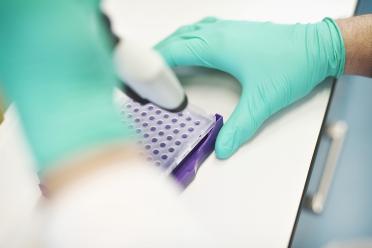
Researchers at the University of East Anglia and the Earlham Institute (EI) have shown that a prostate cancer urine test can identify men at ‘intermediate risk’ who can safely avoid immediate treatment and benefit from ‘active surveillance’ instead.
Previously, the team’s Prostate Urine Risk (PUR) test could identify men with high and low risk cancers - but can now help men with intermediate-risk disease - for whom treatment options had been less clear.
Prostate cancer is the most common cancer in men in the UK. It usually develops slowly and the majority of cancers will not require treatment in a man’s lifetime.
The most commonly-used tests for prostate cancer include blood tests, a physical examination known as a digital rectal examination (DRE), an MRI scan and an invasive biopsy. However, doctors struggle to predict which tumours will progress to a more aggressive form, making it hard to decide on treatment for many men.
Lead researcher Dr Jeremy Clark, from UEA’s Norwich Medical School, said: “While prostate cancer is responsible for a large proportion of all male cancer deaths, it is more commonly a disease men die with rather than from.
“Therefore, there is a desperate need for improvements in diagnosing and predicting outcomes for prostate cancer patients to minimise overdiagnosis and overtreatment while appropriately treating men with aggressive disease, especially if this can be done without taking an invasive biopsy.
“Here at the UEA, we have developed a urine test for prostate cancer called the Prostate Urine Risk Test – or PUR for short.
“The ‘risk’ here refers to the aggressiveness of the cancer and its potential to spread to other organs, which would eventually kill the patient. But prostate cancer is very complex and risk levels vary widely between men.
“Previously, we have shown that PUR can identify men with high-risk cancer which requires immediate treatment and also low-risk cancer that has a very low rate of progression and does not generally need treatment.
“But there is a third category of men with ‘intermediate-risk’, which falls in between these extremes. Around half of men diagnosed with prostate cancer fall into this group and the treatment pathways for them have been less clear, until now.
“It is known that disease progression in intermediate-risk men is associated with the presence of increasing amounts of Gleason pattern 4 cancer in their prostate. Our study shows that the PUR test can assess the amount of Gleason pattern 4 without the need for a biopsy.
“So, not only can PUR measure the presence of aggressive cancer, but it can also measure increasing amounts of aggressive cancer in the prostate.
“This means that it can show us which men at intermediate risk may require treatment and which may instead be managed conservatively with surveillance.
“PUR will also be useful for monitoring disease in men that do not currently require treatment, and flag up the emergence and expansion of aggressive disease,” he added.
The results of this pilot study will be further investigated in a much larger cohort of men using samples collected with a prostate screening box which the patients receive by mail, and return samples by post directly for analysis at UEA.
